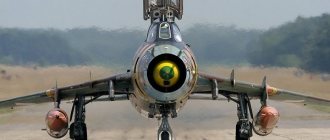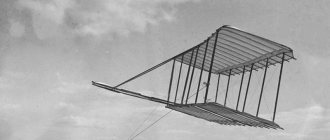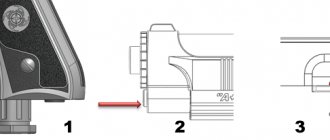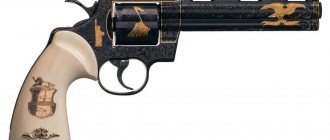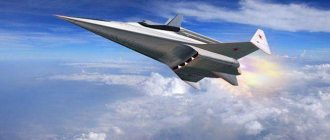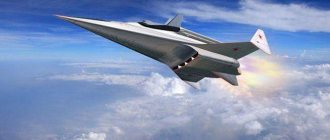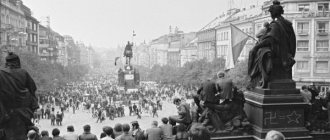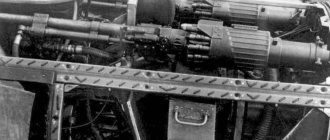| « | And the brick will fly if there is enough traction | » |
| — Sergei Pavlovich Korolev | ||
Stealth against the backdrop of the Nevada desert
Lockheed F-117 Night Hawk
(
“Nighthawk”
, folk
stealth, invisibility
, more often “Nighthawk” - Google
night taxi driver
(or nightjar), not to be confused with the Northrop B-2 Spirit strategic bomber!) - American tactical strike aircraft, a heavier-than-air vehicle, built with using stealth technology. Among pilots, he received the nickname Wobblin' Goblin - lame goblin - due to his impressive flight characteristics.
[edit] In theory
“Bandit” on the Lame Goblin
The device is designed for targeted strikes day and night, in simple and adverse weather conditions, operating without cover. The aircraft uses blanks with laser (accuracy - ±0.1 m), passive radar guidance, passive thermal and radio command guidance (accuracy - operator's hand trembling). The possibility of suspending atomic bombs is provided. Thus, the target is hit in any weather conditions with a probability of 0.8...0.9. With the correct choice of ammunition, weather conditions do not affect the accuracy and efficiency of work against ground targets.
The radar stealth of an aircraft (and the F-117 in particular) means that when it is irradiated by an air defense radar, most of the radiation is scattered and reflected anywhere but back to the receiver antenna, part of the radiation is absorbed by a special coating and/or airframe material and only a small part comes back. That is, there will be light on the radar operator’s screen, but it will be much weaker and closer to the radar than, for example, from the Su-25. And while enemy air defenses figure out who he is (friend or foe / UFO / maize plant / Tu-154), transmit data to anti-aircraft guns / aim missiles / load a slingshot, the F-117 flies up to tactical strike distance, drops gifts and goes to hell.
The fact is that reducing the visibility of the aircraft was achieved through the use of faceted shapes and inclined planes; accordingly, the glider began to look like a figure from a cubist museum. If normal planes are first taught to fly, and then they are greased/bent so that they are not very noticeable on the radar, then this one was first made “invisible”, and then at least they were taught to fly somehow.
Flight characteristics of the US Air Force stealth aircraft
The aircraft's parameters are entirely aimed at achieving the main task. The F-117A is designed for covert penetration of enemy strategic rear targets. The aircraft's relatively short service life in terms of flight range and combat radius means that the main targets of the high-precision guided munitions on board are enemy control communications - headquarters, communications centers, air defense facilities and aviation.
| Aircraft type | F-117A Nighthawk |
| Crew: | 1 |
| Length, m | 20,08 |
| Height, m | 3,78 |
| Wingspan, m | 13,2 |
| Wing area, sq.m | 73 |
| Sweep angle, degrees | 67.30 |
| Weight, kg: empty plane normal takeoff maximum takeoff | 13 380 21 150 23 815 |
| Fuel weight, kg | 5 500 |
| Combat load, kg: when fully charged with incomplete filling | 2 270 2 500 |
| Stealth aircraft speed, km/h: cruising maximum | 905 993 |
| Practical ceiling, m | 13 700 |
| Flight range, km | 1 720 |
| Combat radius, km | 860 |
| Wing load, kg/sq.m.: with normal take-off weight with maximum take-off weight | 290 327 |
| Frontal EPR for monostatic radar in the X-band, sq.m. | 0,025 |
| Thrust-to-weight ratio, kgf/kg: at normal take-off weight at maximum take-off weight | 0,46 0,41 |
| Maximum operational overload | +6g |
The F-117A cockpit looks like a supercomputer control panel
[edit] In fact
A proven Soviet tool for sawing out flying irons
When the project was shown to aerodynamicist Dick Cantrell, he fainted and said: “I don't care what in hell it looks like, I'll get that ugly son-of-a-bitch to fly ! Only the most experienced pilots were put behind the wheel of the 117th, with at least a thousand hours of flight time (this is approximately three to five years in service, for a fighter), so as not to be killed. Trying to correct the situation, Lockheed installed an additional gasket between the steering wheel and the seat - a tricky autopilot that corrected particularly clever control signals, reducing the likelihood of the plane going into a tailspin. But all the same: the statistics of crashes of this Uberdevice tell us that out of seven officially recognized crashes, five occurred either due to the inability of an insufficiently experienced pilot to cope with the controls, or due to errors in the ground preparation of the device.
However, stealth remained a terrible secret; only in 1988 did the UWSP government acknowledge its existence by showing a retouched photograph. In April 1990, the Pentagon held a public demonstration of the “night goblin” to the whole world. The audience was in awe from the mere sight of such a miracle, and a frenzied publicity began. Stealth appeared in magazines, at air shows, in films, computer games and on the Internet. And in the same 1990, production of the F-117 was discontinued, and the money intended for its production was redirected to the Lockheed/Boeing F-22 Raptor (then YF-22) program.
The opportunity to test the top-secret wunderwaffle in action presented itself in 1989. At this time, a democratic deficit began to emerge in Panama, and therefore two F-117s were sent there with the aim of assassinating President Manuel Noriega. But the assassins stuffed with electronics simply missed the target with their bombs. The UWB media stated that the operation was a success because the humane Americans simply wanted to scare the enemy. The people grabbed it, and competent people drew conclusions.
The F-117's finest hour was the Gulf War. Actually, Operation Desert Storm began with an F-117 strike: on the night of January 16-17, 1991, 10 Nighthawks from the 415th squadron of the US Air Force crossed the border of Iraq, reached Baghdad, in the center of the Iraqi capital fucked a 100-meter command tower and a control center for tactical missiles and interceptors, and, being absolutely
undetected by Iraqi air defense radars, returned to base.
Epic win. The Pentagon trumpeted the “super-effectiveness” of stealth bombs with ultra-precise bombs with an impact efficiency of 80-90%. But there is an opinion that only 30% of the “ultra-precision” bombs they dropped hit the target. Theoretically, this is not so bad, compared to ordinary bombs, whose probability of hitting a given square is much lower than one percent (the Allies in World War II achieved as much as 3 percent accuracy of bombs during the bombing of Germashka). But in practice, it turned out that even 30% was achieved only in ideal spherical-vacuum conditions, because the Iraqis often disrupted the aiming of such bombs with elementary means of camouflage (dragging, placing steel sheets under camouflage nets, which created a false target, or setting a fire under the steel sheets and grilled kebabs, which created the effect of a running tank engine). F-117 wreckage.
The same one Until 1999, the F-117 worked mainly as an expensive fashion model. The real deal for him was found in Yugoslavia, when the NATO bloc decided to protect the poor Albanians and give the Serbs a little democracy. On the third day, the USAF experienced unprecedented frustration - the Serbs destroyed this vessel. From what - who knows, according to the official version of both our Ministry of Defense and the Serbian one, it was an S-125 air defense system. There is an opinion that the MiG-29 tried, but who cares if the plane was destroyed at point-blank range and at direct fire. They just banged it and that’s it. And there is a proof.
The American taxpayer began to realize that he had been screwed for many years by passing off a barely flying iron as a super-weapon. The NATO command suffered a severe butt-hurt, now the F-117 flew on a mission only under the protection of fighters hung with HARM anti-radar missiles in order to burn everything around at the slightest appearance of a radar signal. To the great delight of the Eldorado there, the racialized Balkans successfully used old microwave ovens with broken doors as decoys for missiles (sic!)
Of course, with its escort, the “lame goblin” became just a hellishly invisible plane. Do you think it helped? Four days later, on April 1, the Yugoslavs spread rumors that another F-117 had been shot down, although it made it to Zagreb. And another one was shot down on the fifth near Crveni Kot. However, the cunning pendos deny everything and did not include it in the list of official losses.
[edit] Five-minute materiel
How could the air defense system even notice the F-117A, much less open targeted fire on it?
It's simple. An aircraft using stealth technology is visible, detected and noticed from absolutely all radars
.
“Stealth”, we see, is a visibility reduction
, not an invisibility technology. Simply put, stealth works in a similar way to camouflage in your favorite tanks. The lower the effective dispersion area, the shorter the distance a stealth aircraft can be exposed to, that is, dousing the unit with radio-absorbing paint and giving it tricky shapes is similar to hanging a camouflage net and painting it with camouflage: the exposure distance will decrease, but the aircraft (or tank) will not become invisible . And vice versa: the more powerful the radar, the greater the distance the plane will be visible. For example, the radar of the S-125 air defense system (with which the F-117 was shot down in Yugoslavia) will be able to detect the Nighthawk from a distance of about a hundred meters - because the minimum EPR that the S-125 can detect is about 0.3-0.4 m², the EPR of the F-117 ranges from 0.01 to 0.0025 m², depending on the angle. If you take the S-300 air defense system, the radar from here will be able to detect the Nighthawk from a distance of about 50-60 kilometers. And so on.
But the anonymous person will ask a completely reasonable question - if the S-125 could not detect the F-117 at all, then how was it able to shoot it down in the first place? And the answer is simple - the S-125, as a short-range air defense system, had equipment for television-optical sighting and tracking of the Karat target.
This equipment made it possible to fire at targets without using a radar at all - by visual contact, that is, “wherever I look, the missile flies there,” that is, with such guidance, the anti-aircraft complex absolutely doesn’t give a damn whether the aircraft is “stealth” or not, which is very delivers. Well, at least this method delivered the rocket to the “one hundred and seventeenth” ass. Even two missiles. The disadvantages of visual guidance are that you can't shoot far (maximum 10 kilometers) and it is highly dependent on the weather (rain, snow, fog, smoke - you can't shoot at all).
According to other information, the Pindos simply did not calculate that the Serbs still use Soviet radars in the meter range, in which stealth, paradoxically, is still visible a little better than in the Euro-Atlantic decimeter range, since the radio-absorbing materials were designed for it, in particular, this is cellular filler fuselage.
Colonel Zoltan Dani looks at you like a downed F-117 On the left is Lieutenant Colonel Dale Zelko, the pilot of that same unfortunate F-117. On the right is Colonel Zoltan Dani, the anti-aircraft gunner who shot down that unfortunate F-117. The second one had stronger eggs, but you couldn’t tell from the outside. Many years later, they are sworn friends, and they cook pancakes together in the same kitchen. Zelko is on the left, Dani is on the right. Such things!
In addition, the anti-aircraft gunner who commanded that air defense missile system crew was very prepared, because he studied in Sovka (his name is Zoltan Dani, at the moment he works as a baker in his own bakery, and what is especially striking is on the day the F-117 was shot down, that is, March 27 , he bakes signature loaves in the shape of this flying iron). And in general, the air defense system was in an ambush, and the Nighthawk pilot did not expect the fucked up thing. I even flew along the same route for the fourth time in a row, relaxing my buns from the feeling of my invisibility.
According to Dale Zelko, the pilot of that same F-117: “There was very low cloud cover. I saw the rocket when it had already crossed the layer of clouds, immediately after launch. She walked at an angle of 50 degrees towards me. And as soon as I saw her, I realized: I had been figured out. The first missile passed very close to the plane. So close that the plane shook.”
This destroyed F-117 immediately buried the entire series of aircraft, forever removing the stigma of “invulnerability,” and soon all the remaining aircraft were taken to a landfill. Its last combat missions were carried out in 2003, in conditions of practically suppressed air defense.
Such things. Comrade Zoltan also claimed that he was able to shoot down a B-2 at the same time. In general, the Serbs reported the downing of 2 such aircraft - aircraft under the names “Spirit of Washington” and “Spirit of Missouri”. True, both B-2s “shot down” in Yugoslavia then suddenly “resurrected” in the skies over Iraq in 2003, and just as suddenly “resurrected” at air bases in the United States for the period from 2006 to 2008. However, no one cares about this anymore.
[edit] What's next?
After Serbia, stealth fighters also fought in Iraq in 2003, but without any PR. Congress decided that it was enough to feed the goblin cavalry, in 2006 the first ten units were removed from service, and then they were slaughtered in small batches. On April 22, 2008, the remaining four F-117s made their last flight. Goodnight, Night Hawk.
Design of the American Lockheed F-117 Nighthawk
Fuselage and aerodynamics of the Stealth
When designing the airframe of a stealth aircraft, engineers had to completely reshape the usual ideas about the aerodynamics of an aircraft. The “flying wing” aircraft design is not new in the American aircraft industry.
Previously, Nortrop built and operated the XB-35 and YB-49 fighter models with varying degrees of success. Two decades later, Lockheed took the path of complicating the task and added new technologies to reduce visibility - stealth - to the unusual scheme.
New technologies were used during construction.
The wing has several features:
- large sweep angle;
- sharp leading edge;
- no roundings in the profile.
The entire fuselage consists of rectangular and trapezoidal blocks of flat section. This shape is used to better reflect radio waves in flight. The concept in which planes without roundings and with a large number of sharp corners reflect directional waves well is called faceted.
See also the article Kukuruznik An-2 and its modifications
Various materials were used in the manufacture of the airframe:
- composites;
- radio-absorbing coatings.
The share of metal alloys amounted to only 10% of the total mass of the airframe. The EPR of the F-117A is several orders of magnitude smaller than that of other machines for similar purposes.
Fighter fuselage
The aerodynamic quality of the model was 4 units. This led to a noticeable decrease in combat characteristics:
- flight at supersonic speed became impossible;
- flight range decreased;
- the combat load has decreased;
- The maneuverability of the aircraft has decreased significantly;
The fuselage is painted black with ferromagnetic paint.
Control system
The fly-by-wire aircraft control system has four-fold channel redundancy. To ensure airframe stability in yaw and pitch, a special automatic system is installed on the F-116 aircraft.
The control system is equipped with a computer program.
It is equipped with a computer program that promptly issues a ban to the pilot from performing maneuvers that could lead to disaster.
Chassis
The traditional three-wheel chassis design is represented by one steerable front wheel. The relatively low weight of the airframe allowed the designers to make the two main struts similar (single-wheeled).
To ensure a safe landing, the design includes a brake hook. To reduce landing speed, the aircraft is equipped with a braking parachute.
Three-legged chassis design
Avionics
To deprive the air defense of a potential enemy of the possibility of detection when approaching a target, the Nighthawk is not equipped with an on-board radar. Navigation and target tracking on board the aircraft are carried out in passive mode. For the same reason, there are no active electronic warfare systems.
Navigation is carried out in passive mode.
Navigation system - double action:
- satellite;
- inertial.
Sighting and navigation equipment:
- short-term laser illumination of the target;
- infrared cameras.
To prevent reflection of enemy radar signals, retractable search equipment is located inside the fuselage.
Armament
In terms of the nature and number of combat missions it performs, the Nighthawk is an extremely highly specialized aircraft. He cannot engage in open air combat with enemy aircraft. Hence the specificity of the design. The F-117A has no external weapons mounts at all. The aircraft's ammunition has two features:
- placement in the fuselage;
- high accuracy of guided missiles (±0.1 m, regardless of the nature of the target, time of day and weather conditions).
Armament of the fighter
See also the article Su-47 Berkut fighter and its technical characteristics
Unguided munitions are not loaded on board the aircraft.
- Compartment type – two-section.
- Compartment dimensions – 4.7 x 1.75 m.
Range of weapons:
- GBU-10 or GBU-27 – 2 x 907 kg;
- missiles – 2 x AGM-88 HARM or 2 x AGM-65 “Maverick”;
- atomic bombs - 2 x B-61 or 2 x B-83;
- submunitions.
It is possible to install guides for the AIM-9 “Sidewinder” missile launcher on beam holders.
Release of the braking parachute during landing
[edit] About cutting budget money
Imperial pathos of Pindosian people
Anonymous, do you know how much money it took to create the F-117? The program cost 6.56 billion USD, including R&D. The result was the creation of an angular bucket with incredibly expensive enamel, which could barely fly, but cost 42.6 million USD. But did Lockheed fight its way to the budget trough just to retreat so easily? Those in charge convinced everyone that this phantasmagoric crap is the very wunderwaffle that the USAF urgently needs. True, the F-117 had to not only fly, but also fight. Therefore, a number of upgrades were carried out, increasing the cost of stealth to 111.2 million USD per piece. A total of 59 F-117s were built (that’s 6.56 billion USD). Plus spare parts. Plus advertising the company as the creator of the coolest aircraft in the world. Can you imagine how much the Lockheeds got for promoting an aircraft that could only be used to fight the Honduras, subject to complete air supremacy? Now let’s estimate the cost of the base in Nevada for the “lame goblins,” their maintenance, ammunition production (the cost of one GBU-27 bomb is 55 thousand USD), etc. In short, everyone was in business. And you say Mace...
But this is not the limit for the bottomless wallet of the Pindos taxpayer - one Northrop B-2 Spirit cost about 2 billion USD in 1997 prices (since then the price of gold has increased 5 times, the price of oil has also increased approximately 5 times, then in 2012, this wunderwaffle would have cost all of $10 billion, which, by the way, is about 3 times the cost of 75 tons of gold bars, the mass of which is approximately equal to the mass of this wunderwaffle of yours), and only 20 of them were built, which in total approximately equal to the capitalization of companies such as IBM, Gazprom or Microsoft (this Rospil and rollback of yours is resting - and the annual GDP of the Russian economy is 5 times less than that of Pindos).
As a guide, the cost of one Su-27 is about 30 million USD in the export version. The F-117 was not exported at all.
- In general, hypothetically, it’s also possible to spend so much money and not waste it, but out of sheer stupidity it’s also possible to spend it on business. To do this you need:
- buy a test site for both Lockheed and Northrop
- build housing there for specialists
- waste money so that businesses can come up and sell consumer goods for the landfill staff!
- ??????
- PROFIT in the form of remaining owned landfills and created jobs (for those who like to fight unemployment, it’s a plus)
Simply put, the taxpayer pays for the construction of almost a new city.
In addition, there is always the option that part of the money was used for SUDDENLY government needs - namely, for all sorts of TOP SECRET, CLASSIFIED and other DATA REMOVED.
Exploitation
The existence of the F-117 aircraft was first officially recognized on November 10, 1988, when the Pentagon issued a press release describing the history of the aircraft and released one retouched photograph.
The first public display of two F-117s took place on April 21, 1990. In 1991, after the Gulf War, the Night Hawk was demonstrated at the Paris Air Show. At first, all F-117s were in service with the 4450th Task Force at Tonopah Air Force Base, Nevada, Tonopah Test Range Airport. In 1989, the group became part of the 37th Tactical Fighter Wing. In 1992, all aircraft were transferred to Holloman AFB to the 49th Fighter Wing. They were in service with three squadrons: two combat (8th Fighter “Black Sheep”, 9th Fighter “Flying Knights”) and one training squadron (7th Combat Training Squadron “Screaming Demons”).
The F-117 pilots called themselves "Bandits." Each of the 558 "bandits" who ever flew on the Night Hawk had its own serial number; thus, for example, Brigadier General Gregory Feest "Bandit 261" was the 261st pilot cleared to fly.
Accidents and disasters
- Over the entire history of operation of F-117 aircraft, according to official data, 7 aircraft were lost (just over 10% of the total number built), including one F-117 that was shot down during combat operations. The Nighthawks flew a total of about 220,000 hours, that is, the flight time per loss was about 31,000 hours.
- April 20, 1982 - F-117A (serial number 80-0785), Lt. Col. Bob Ridenhauer "Bandit 102". The plane crashed on takeoff due to an incorrectly configured flight control system at the factory. The pilot did not have time to eject, received serious injuries and was written off from flight work.
- July 11, 1986 - F-117A (serial number 81-0792), Major Ross Mulhare "Bandit 198". The plane collided with the ground near Bakersfield, California, during a night flight. The reason was the disorientation of the pilot, who had little flying time on the F-117. Major Mulhare died.
- October 14, 1987 - F-117A (serial number 83-0815), Major Michael Stewart "Bandit 231". The plane collided with the ground near Tonopah during a night flight. The reason was the disorientation of the pilot, who had little flying time on the F-117. Major Stewart was killed.
- August 4, 1992 - F-117A (serial number 85-0801), captain John Mills "Bandit 402". The plane caught fire during a night mission near Holloman Air Force Base and exploded in mid-air. The reason is an error by ground technical personnel during maintenance. Captain Mills ejected safely.
- May 10, 1995 - F-117A (serial number 85-0822), captain Kenneth Levens "Bandit 461". The plane crashed into the ground near Zuni, New Mexico, during a night flight. The alleged cause is the disorientation of the pilot, who had little flying time on the F-117. Captain Levens died.
- September 14, 1997 - F-117A (serial number 81-0793), Major Bryan Knight "Bandit 437". The plane disintegrated in mid-air and crashed into a building during an air show in Chesapeake, Maryland. The accident occurred due to a technical reason, which led to the pilot losing control. 4 people were injured on the ground. Major Knight ejected safely.
[edit]Hollywood Star
True oldfags will say what kind of game this is.
Even before the start of open PR, Bloody Gebnya in the USSR described the subject in dull action films with a cultural bias. For example, back in 1985, the decaying West was forced to cut up top-secret developments.
With the start of open PR for the F-117, he naturally began to star in dull American action films with senile plots. The first was the film The Philadelphia Experiment 2
(1992), about how the Nazis changed the space-time continuum, stole an F-117 with a nuclear bomb and won WW2.
The next year, Interceptor
, where the stealth was stolen by terrorists.
In 1995, the subject appeared in Capture 2
.
But the most enchanting opus was Ordered to Destroy
(1996), where paratroopers land from a stealth aircraft into a Boeing 747 captured by terrorists.
An epic victory of insanity, firstly, there is nowhere to cram troops into the F-117, except perhaps into the bomb bay, this is not a corn farm. Secondly, this pyramid is not so invisible that you could stupidly fly right up to the plane and put a pipe on it, and they wouldn’t even notice any turbulence or anything. In the film, the captured pilots didn’t even pretend - they didn’t seem to notice the external plane. But the cattle gobbled it up. In the 2005 film Stealth
the subject was equipped with artificial intelligence and was one of the main characters along with live actors. Only in this film it wasn’t the subject itself, but an invented super-mego-shopdesdetsnakh invisible plane.
At the same time, the adjective “invisible” was also advertised. Even in one of the episodes of DuckTales
the flight of Zigzag and Scrooge on a completely invisible plane is played out.
Games about the F-117 were much more interesting. Here you can call the F-117A Stealth Fighter
, a Microprose conversion from the famous F-19.
F-117 Night Storm
, released on SEGA Mega Drive,
gained wider popularity The flight simulator included both real US military campaigns and fictional ones (for example, the introduction of democracy in North Korea). The game was quite difficult, the small amount of ammunition limited the destruction of enemies to reasonable limits, and stealth could be knocked down with a couple of hits. The F-117 was also present in the no less famous game Jungle strike
, where it had to be used to complete missions at level 7.
It was never invisible there; the fundamental difference from the main helicopter is endless fuel! The scriptwriters even somehow clumsily tried to explain this infinity with “terms” in the mission briefing. Well, there is no way to hover in the air, which is why this mission is extremely difficult - with such a small view (top-side view), he constantly crashes into all the statues and hangars. The F-117 is also present in strategies - Act of war
(bomber),
Command & Conquer: Generals
(fortification fighter), and in this
Civilization
, where would we be without it.
Power point
The aircraft's power plant consists of two F404-F1D2 bypass turbofan engines, designed by engineers from the General Electric Corporation. At maximum mode, each develops a thrust of 4,850 kgf.
F404-F1D2
these turbojet engines are installed on board
There are adjustable air intakes on both sides of the fuselage. The material from which they are made is a composite with a high radio absorption coefficient. This is done to reduce visibility in flight.
Another difference in the design of the air intakes, which significantly reduces radio signature, is the presence of a flow separator. The air that does not enter the engine is directed into a flat-section nozzle shielded by the wing. Its dimensions are 165x25 cm.
The bottom of the nozzle panels is equipped with special tiles that absorb heat well. Number of nozzles - 2.
In addition to the Nighthawk, the F404-F1D2 engine was equipped with eleven types of combat aircraft, including the F/A-18 Hornet carrier-based attack aircraft.
Nighthawk engine - F404-F1/D2 from General Electric Corporation
[edit] Similar to the F-117... F-16
The super-sophisticated F-16C also “found a job” in the Balkans. Two Pindos planes peacefully patrolled the territory where democracy was being implanted[1]. At the same time, not far from them, the Bosnian Serbs were racing the Orthodox mobile air defense system 2K12E “Cube” (SA-6). The guys in the “cube” came up with a cunning plan to sell the flying Pindos irons for scrap metal, which was successfully implemented IRL: to hell, one F-16C was shot down in two salvos (despite the fact that the downed loser was protected by an AWACS aircraft). Fortunately, the pilot of the downed plane managed to eject and spent six days making his way to his own people, while removing a pile of bricks along the way and remembering with “warm words” the iron manufacturer, General Dynamics. According to the plot, the delivery cranberry “Behind Enemy Lines” was even filmed, where the racial Italian after his grandmother Mashkov portrayed an urku named Sasha, who was sawed out by the same pilot crawling on the ground.
Combat use
The aircraft was in operation from 1983 to 2008, and managed to take part in several regional conflicts. During operation, seven aircraft were lost, only one of which was shot down by enemy anti-aircraft fire. The rest crashed in accidents caused by the pilots or due to technical faults.
The F-117's baptism of fire was the American invasion of Panama in 1989.
These aircraft were first used en masse during Operation Desert Storm in 1991. F-117s showed very high efficiency during this conflict: in one night they destroyed almost all Iraqi Tu-22s.
The next conflict in which the Americans used this aircraft on a massive scale was the war in Yugoslavia in 1999. It was then that the “stealth plane” was shot down. It was destroyed by a Serbian anti-aircraft battery armed with an obsolete Soviet S-125 anti-aircraft system. The Serbs claimed the destruction of one or two more vehicles, but these data are quite controversial.
The last significant conflict in which the F-117 was involved was the second US Iraq campaign (2003).
Initially, this aircraft was planned to be used until 2022, but the high costs of the F-22 Raptor and F-35 programs forced the US military to abandon it almost a decade earlier.
Already in the middle of the last decade, the Nighthawk was an obsolete machine. Due to the rapid development of means of detecting aircraft, it lost its main advantage - the title of “invisible aircraft”, and the design flaws inherent in it initially turned the F-117 into a very expensive and extremely vulnerable machine. And the cost of maintaining the Nighthawk was quite high, so this decision seems quite natural.
The F-117 became a real stand where the Americans worked out all the nuances of using stealth technology. Without exaggeration, this aircraft can be called a unique machine; the F-117 was the first in its class, so many of its flaws can be forgiven. Largely thanks to the Nighthawk, fifth-generation stealth aircraft took to the skies: the F-22 Raptor and F-35.
[edit] Gallery
| 1 | 3 | yes | Show | Hide |
|
History of creation[edit]
The only ground-based F-117 project, the F-117A, was developed. The F-117B, F-117N (deck-based) and A/F-117X projects proposed by Lockheed were rejected.
Designation and nameedit
The official name of the F-117 in the US Air Force is Night Hawk .
- English
Nighthawk
), although the combined spelling “Nighthawk” is also found.
According to the US military aircraft designation system, the letter F is assigned to fighter aircraft. The reason why the Night Hawk was classified as a fighter and was used by fighter squadrons remains unclear; Contrary to the popular culture image of the " Stealth
", the F-117 is a tactical strike aircraft (bomber/attack aircraft) and was never intended to perform fighter missions. A similar situation occurred with the F-111 tactical/strategic bomber, which also bore the “fighter” designation.
[edit] Notes
- Bosnia and Herzegovina
| [ + ] F-117 Nighthawk - the key to victory! | |||||||||||||||||||||||
| |||||||||||||||||||||||
| [ + ] The F-117 is the pride of the aircraft industry. | |||||||||||||
| |||||||||||||
Combat use[edit]
F-117 in Kuwait, 1998
- US Invasion of Panama (1989)
- Gulf War (1991) See also Bombing of the Amiriya air-raid shelter
- On the first night of the war, almost the entire fleet of Iraqi Tu-22 long-range bombers was destroyed.
Lose itEdit
Wreckage of a downed F-117 in the Belgrade Museum
March 27, 1999 - F-117A (serial number 82-0806), Lieutenant Colonel Dale Zelko. The plane was shot down near the village of Budzhanovci during a NATO military operation against Yugoslavia. The pilot ejected safely and was evacuated by a search and rescue team. According to the Serbian version, the F-117 was shot down by the S-125 anti-aircraft missile system (5V27D missile produced by the XX Party Congress plant (now AVITEK) in 1976) of the 3rd battery of the 250th air defense brigade (battery commander - Zoltan Dani). The target was hit by two missiles (the first tore off the wing, and the second hit the plane itself), 17 seconds after the “fire” command.
There were versions about the participation of the Kub air defense system or MiG-29 and MiG-21 fighters: according to some sources (in particular, the Russian author Vladimir Ilyin and the Argentine Diego Zampini), the F-117 was shot down by a MiG-29 fighter piloted by Lieutenant Colonel Gvozden Dyukich (at the same time, the Serbian newspaper Politika reports that “Gvozden Đukić ”
) was a nickname used by Zoltan Dani during the war). The pilot of the F-117 is sometimes mistakenly identified as Captain Ken Dwiley, since he flew the aircraft in the United States and had his name written on the fuselage.
April 30, 1999 - An F-117A was damaged, possibly by a S-125 anti-aircraft missile system.
Unconfirmed losses and damageedit
- April 5, 1999 - F-117A, according to Russian author Vladimir Ilyin with reference to Serbian data, was destroyed during an attack on the Crveni Kot TV tower, but the loss of this aircraft by the Americans is not confirmed.
- April 1, 1999 - F-117A, according to Russian author Vladimir Ilyin, was damaged and made an emergency landing
- May 20, 1999 - F-117A, according to Russian author Vladimir Ilyin with reference to some Serbian data, was destroyed by a MiG-29 fighter over Kosovo. The Argentine author Diego Zampini, in his article devoted to the actions of the Serbian MiG-29s, does not mention this victory, and it is not in the final list of victories of the Serbian pilots he provides. According to the Ukrainian author Mikhail Zhirokhov, the last combat mission of the MiG-29 during the war was carried out on May 4.


